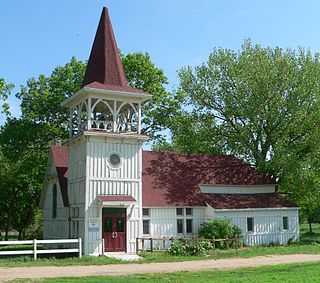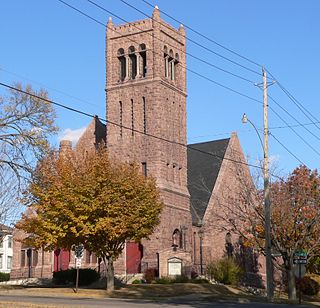LeMoyne–Owen College is a private historically black college affiliated with the United Church of Christ and located in Memphis, Tennessee. It resulted from the 1968 merger of historically black colleges and other schools established by northern Protestant missions during and after the American Civil War.

The American Board of Commissioners for Foreign Missions (ABCFM) was among the first American Christian missionary organizations. It was created in 1810 by recent graduates of Williams College. In the 19th century it was the largest and most important of American missionary organizations and consisted of participants from Protestant Reformed traditions such as Presbyterians, Congregationalists, and German Reformed churches.

The Santee Sioux Reservation of the Santee Sioux was established in 1863 in present-day Nebraska. The tribal seat of government is located in Niobrara, Nebraska, with reservation lands in Knox County.

The Moses Merrill Mission, also known as the Oto Mission, was located about eight miles west of Bellevue, Nebraska. It was built and occupied by Moses and Eliza Wilcox Merrill, the first missionaries resident in Nebraska. The first building was part of facilities built in 1835 when the United States Government removed the Otoe about eight miles southwest of Bellevue. Merrill's goal was to convert the local Otoe tribe to Christianity; he had learned the language and translated the Bible and some hymns into Otoe.

The Episcopal Diocese of South Dakota is a diocese of the Episcopal Church with jurisdiction over the state of South Dakota.

Fontanelle is an unincorporated community and census-designated place (CDP) in Washington County, Nebraska, United States. The site of repeated incursions by the neighboring Pawnee tribe, Fontanelle was an early boom town in the Nebraska Territory, but waned in importance after failing to secure a railroad connection in the late 19th century. The 1860 Federal Census showed the town having dozens of residents, including farmers, carpenters, blacksmiths, clergymen, lawyers, and other professions. The town dwindled from a population of 500 to a few dozen after an early university left in the 1870s, it failed to get a railroad connection, and the nation suffered a financial depression.

The Church of Our Most Merciful Saviour, also known as the Santee Mission, built in 1884, is a historic Carpenter Gothic style Episcopal church located on the Missouri River in the Santee Indian Reservation in Santee, Nebraska. Although its side windows are not arched, it otherwise exhibits all the common features of Carpenter Gothic churches: board and batten siding, lancet windows on the front along with a circular rosette window, belfry tower on the side and main entrance on the side though the belfry tower.

Bethany Congregational Church is a United Church of Christ house of worship located in Thomasville, Georgia in south Georgia's Thomas County. It was founded on February 1, 1891, by the American Missionary Association as the chapel and worship center of the Allen Normal and Industrial School, an educational institution for African American students. The school operated from 1885 to 1933, and the church remained after the school property was razed in 1935.

Pilgrim Congregational Church is a historic congregation of the United Church of Christ in Cleveland, Ohio, United States. Constructed in the 1890s for a congregation founded in the 1850s, it was named a historic site in the 1970s.

St. Thomas Episcopal Church is a parish church in the Episcopal Diocese of Iowa. The church is located in Sioux City, Iowa, United States. The church building was listed on the National Register of Historic Places in 1984.

Plymouth Congregational Church of Lawrence, Kansas is an affiliate of the United Church of Christ that was established in 1854, months after the Territory of Kansas was opened to settlement. The present-day church building, built in 1870, is listed on the National Register of Historic Places.

First Congregational Church is located in Burlington, Iowa, United States. It was listed on the National Register of Historic Places in 1976. The church is also a contributing property in the Heritage Hill Historic District.

The First Congregational Church, also known as Iglesia Pentecostes Evangelica Principe de Paz, is a house of worship located in Sioux City, Iowa, United States. An architectural rarity, it is one of a small group of churches in the Prairie School style of architecture. Designed primarily in the Prairie style with some eclectic touches by architect William L. Steele, its horizontal lines are emphasized by Roman brick and crisp rectilinear forms. Somewhat at variance are the distinctive dome and the prominent round heads on the windows.

The Evergreen Congregational Church and School is a historic church and school at 497 Meridian Road in Beachton, Georgia. It is notable for its architecture, for its association with social history of the area, and for its association with civil rights leader Andrew Young, who served as its pastor from 1957 to 1959. It was added to the National Register of Historic Places in 2002.

Pilgrim Congregational Church is a historic church building at 540-544 Columbia Road in the Dorchester neighborhood of Boston, Massachusetts. The brick Romanesque Revival building was built 1890–1893 to a design by Worcester architect Stephen C. Earle. The congregation for which it was built was established in 1862; this was its second purpose-built church. The congregation was divided when the Romsey Congregational Church was established in 1893 to serve congregants living closer to Savin Hill; the two congregations were reunited in 1930, and stained glass windows from the Romsey Church were installed in this building.

The building formerly known as Godalming Congregational Church was the Congregational chapel serving the ancient town of Godalming, in the English county of Surrey, between 1868 and 1977. It superseded an earlier chapel, which became Godalming's Salvation Army hall, and served a congregation which could trace its origins to the early 18th century. The "imposing suite of buildings", on a major corner site next to the Town Bridge over the River Wey, included a schoolroom and a manse, and the chapel had a landmark spire until just before its closure in 1977. At that time the congregation transferred to the nearby Methodist chapel, which became a joint Methodist and United Reformed church with the name Godalming United Church. The former chapel then became an auction gallery before being converted into a restaurant; then in 2018 the premises were let to the Cotswold Company to be converted into a furniture and home accessories showroom. In 1991 the former chapel was listed at Grade II for its architectural and historical importance.

Beuttler & Arnold was an architectural firm in Sioux City, Iowa that designed several works that are listed on the National Register of Historic Places for their architecture.
Eisentraut, Colby, & Pottinger was an architectural firm located in Sioux City, Iowa. It designed a number of buildings, including Carnegie libraries and courthouses, several of which are listed on the National Register of Historic Places. It included principal John P. Eisentraut (1870-1958) and has also been known as Eisentraut and Co..

Camp Creek School, Otoe County District No. 54, in Otoe County, Nebraska near Nebraska City, Nebraska, was built in 1870–75. Its building is one of few surviving one-room schoolhouses in Nebraska. It was listed on the National Register of Historic Places in 1980.

The Shrine of the Black Madonna of the Pan African Orthodox Christian Church, or more simply the Shrine of the Black Madonna, is a church building located at 7625 Linwood Street in Detroit, Michigan. It is significant for its association with civil rights leader Rev. Albert B. Cleage Jr., and as the location of many significant 20th century African American civil rights activities. The building was listed on the National Register of Historic Places in 2021.






















